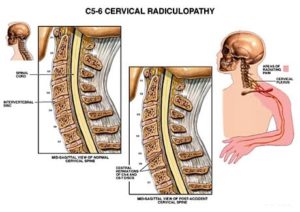What Causes A Cervical Radiculopathy
Radiculopathy happens when other medical conditions cause pressure on the spinal nerves.
These conditions are:
Herniated Disc
Disc Herniation occurs because of erosion in the spinal disc, which allows the inner annulus to enter the spinal canal. The escaped tissue presses on the nerves in the spinal canal to cause radiculopathy.
Scoliosis
A spine that curves sideways is called scoliosis. Scoliosis might cause radiculopathy because abnormal spine curvature can pinch the nerves in your spine.
Diabetes
Diabetes can cause radiculopathy by reducing blood supply to the nerves in the spine.
Other Causes
Other medical conditions that cause radiculopathy include spinal tumors, sciatica, osteoarthritis, and bone spurs.
What Are The Symptoms of Cervical Radiculopathy
People with radiculopathy often report the following symptoms:
- Back pain or pain in the shoulders, arms, or legs. Pain from radiculopathy might get worse if you cough, sneeze, or engage in physical activity.
- Weakness in the limbs and slower reflexes.
- Numbness, tingling or oversensitivity in the limbs.
Your symptoms will vary, depending on the type of radiculopathy you have. Your doctor will conduct a thorough diagnostic assessment to determine which nerve is pinched and causing your symptoms.
How Is A Cervical Radiculopathy Diagnosed?
The doctor will conduct a physical examination to determine the site affected by radiculopathy. The physical examination includes the following tests:
- X-ray
- MRI
- CT scan
What Are The Treatment Options For A Cervical Radiculopathy?
Radiculopathy can be treated by two methods:
- Medication
- Surgery
Medication
In most cases, over-the-counter drugs like ibuprofen, acetaminophen, etc. can provide pain relief. Doctors may also prescribe steroids if needed. Medication is a conservative, but no less effective treatment for radiculopathy.
However, if your case is severe and nerve damage is advanced, your neurologist could suggest surgery.
Surgical Treatment
Through surgery, doctors operate on the spinal disc and the herniated disc to relieve the pressure on compressed nerves.
At Houston Neurosurgery &Spine, we employ noninvasive surgical methods to provide relief from compressed nerves and the corresponding pain. These surgical methods include:
Arthroplasty
Arthroplasty involves replacing the disc in the cervical spine using microscopic technology. Here, we locate the pain’s exact origin by entering through the front of the neck.
Once the pain is pinpointed, we replace the natural, dysfunctional disc with a synthetic disc that functions as a healthy one. The surgery lasts from an hour to1.5 hours, and the results are seen fairly quickly.
Posterior Cervical Foraminotomy
Posterior cervical foraminotomy is an outpatient surgical procedure performed while the patient is under anesthesia. This procedure involves surgically removing the compressed nerves in the spine and vertebral region.
Lumbar Microdiscectomy
Lumbar microdiscectomy is a minimal access surgical approach that reduces open-surgery related trauma. The surgery has shorter recovery times and results in less scarring and negligible post-surgery pain. This minimally invasive surgery removes bulges from the herniated region, providing pain relief from compressed nerves.
Using X-ray technology to pinpoint the pain’s origin, surgeons monitor the procedure with a microscope and use a retractor tube to remove the bulge. Once the nerve is free, the retractor tube is pulled out, and the incision is closed using plastic surgical methods to hide the incision. Lumbar microdiscectomy is highly effective, and patients are able to walk easily within 24 hours of the surgery.
Recovery
You might have to stay in the hospital for up to 2 days after surgery, but you’ll be able to walk or eat by yourself within a day of the procedure. Some patients experience hoarseness or difficulty swallowing if they get surgery for cervical radiculopathy and must wear a rigid cervical collar for a time. You will also have to go for physical therapy to recover limb mobility and muscle strength. You can go back to normal activities 4 to 6 weeks after the surgery.
At Houston Neurosurgery &Spine, we promise minimally invasive surgery that provides long-term pain relief. We take most insurance plans, so book your appointment with us in Houston.

